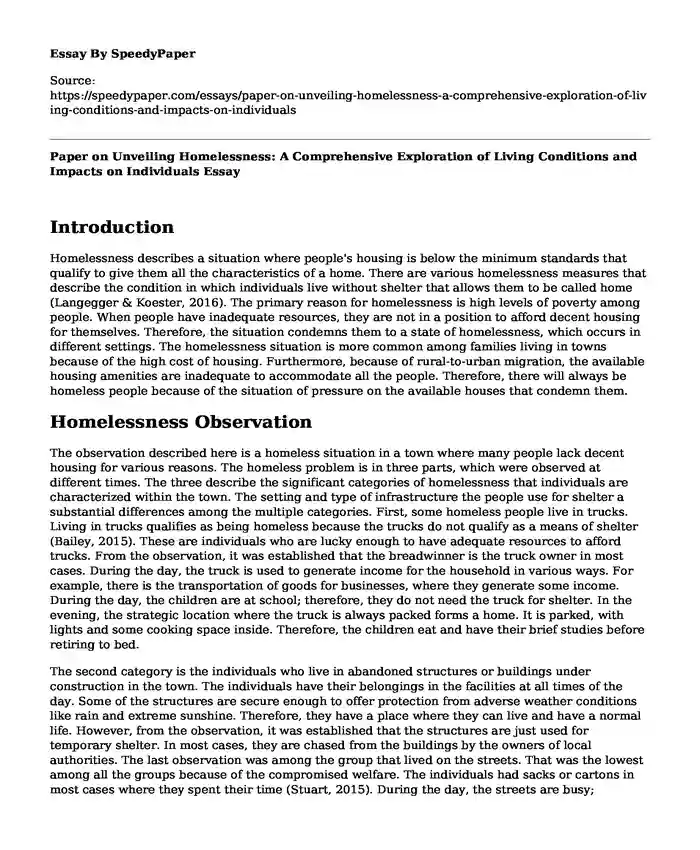Introduction
Homelessness describes a situation where people's housing is below the minimum standards that qualify to give them all the characteristics of a home. There are various homelessness measures that describe the condition in which individuals live without shelter that allows them to be called home (Langegger & Koester, 2016). The primary reason for homelessness is high levels of poverty among people. When people have inadequate resources, they are not in a position to afford decent housing for themselves. Therefore, the situation condemns them to a state of homelessness, which occurs in different settings. The homelessness situation is more common among families living in towns because of the high cost of housing. Furthermore, because of rural-to-urban migration, the available housing amenities are inadequate to accommodate all the people. Therefore, there will always be homeless people because of the situation of pressure on the available houses that condemn them.
Homelessness Observation
The observation described here is a homeless situation in a town where many people lack decent housing for various reasons. The homeless problem is in three parts, which were observed at different times. The three describe the significant categories of homelessness that individuals are characterized within the town. The setting and type of infrastructure the people use for shelter a substantial differences among the multiple categories. First, some homeless people live in trucks. Living in trucks qualifies as being homeless because the trucks do not qualify as a means of shelter (Bailey, 2015). These are individuals who are lucky enough to have adequate resources to afford trucks. From the observation, it was established that the breadwinner is the truck owner in most cases. During the day, the truck is used to generate income for the household in various ways. For example, there is the transportation of goods for businesses, where they generate some income. During the day, the children are at school; therefore, they do not need the truck for shelter. In the evening, the strategic location where the truck is always packed forms a home. It is parked, with lights and some cooking space inside. Therefore, the children eat and have their brief studies before retiring to bed.
The second category is the individuals who live in abandoned structures or buildings under construction in the town. The individuals have their belongings in the facilities at all times of the day. Some of the structures are secure enough to offer protection from adverse weather conditions like rain and extreme sunshine. Therefore, they have a place where they can live and have a normal life. However, from the observation, it was established that the structures are just used for temporary shelter. In most cases, they are chased from the buildings by the owners of local authorities. The last observation was among the group that lived on the streets. That was the lowest among all the groups because of the compromised welfare. The individuals had sacks or cartons in most cases where they spent their time (Stuart, 2015). During the day, the streets are busy; therefore, they cannot live there. They secure their belongings in some corners and go on with their daily activities. At night, they come back and lay their belongings down to rest. That was the most compromised group because of the high level of insecurity and extreme weather conditions.
Conclusion
From the observation, it is established that homelessness is a problem that affects many people. The shelter where the people live is not secure enough to provide the basic need for protection. Therefore, the quality of life in the individual's lives is compromised. Homelessness is into three major categories according to the observation. The individuals who live on the streets are the unluckiest because of the conditions they live in. The homelessness situation keeps deteriorating based on the high population in towns and the high level of unemployment.
References
Bailey, J. (2015). Food-sharing restrictions: A new method of criminalizing homelessness in American cities. Geo. J. on Poverty L. & Pol'y, 23, 273. https://heinonline.org/HOL/LandingPage?handle=hein.journals/geojpovlp23&div=14&id=&page=
Langegger, S., & Koester, S. (2016). Invisible homelessness: Anonymity, exposure, and the right to the city. Urban Geography, 37(7), 1030-1048. https://www.tandfonline.com/doi/abs/10.1080/02723638.2016.1147755
Stuart, F. (2015). On the streets, under arrest: Policing homelessness in the 21st century. Sociology Compass, 9(11), 940-950. https://onlinelibrary.wiley.com/doi/full/10.1111/soc4.12324
Cite this page
Paper on Unveiling Homelessness: A Comprehensive Exploration of Living Conditions and Impacts on Individuals. (2023, Dec 30). Retrieved from https://speedypaper.com/essays/paper-on-unveiling-homelessness-a-comprehensive-exploration-of-living-conditions-and-impacts-on-individuals
Request Removal
If you are the original author of this essay and no longer wish to have it published on the SpeedyPaper website, please click below to request its removal:
- Free Essay on Gender Bias in American Online Newspaper Language
- Corporate Social Responsibility Essay Sample
- Essay Example on John Brown
- Free essay: The Portrayal of Indigenous People in the Media
- Essay Sample on The Feminine Mystic Analysis
- Essay Sample on The Absence of Race in Technological History Studies
- Critical Thinking for Homeland Security - Free Essay
Popular categories





